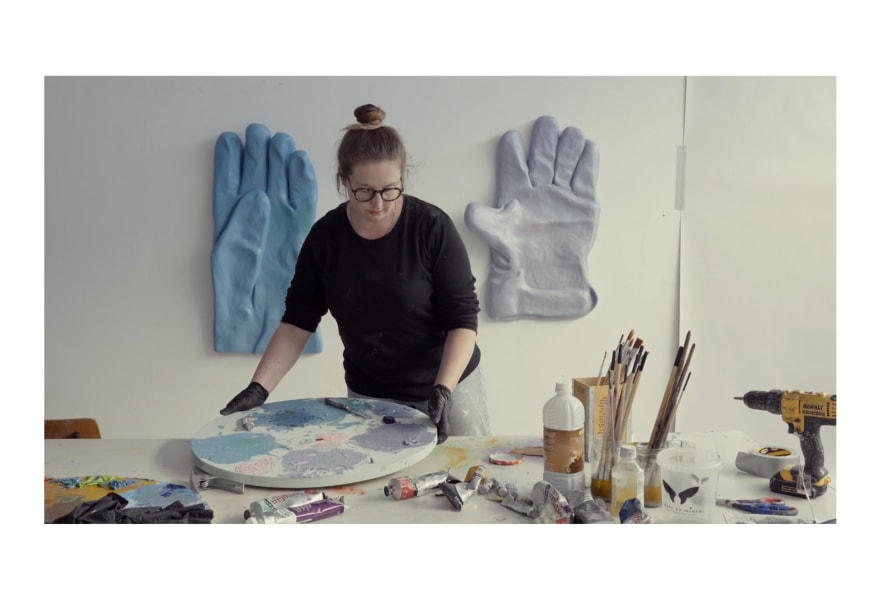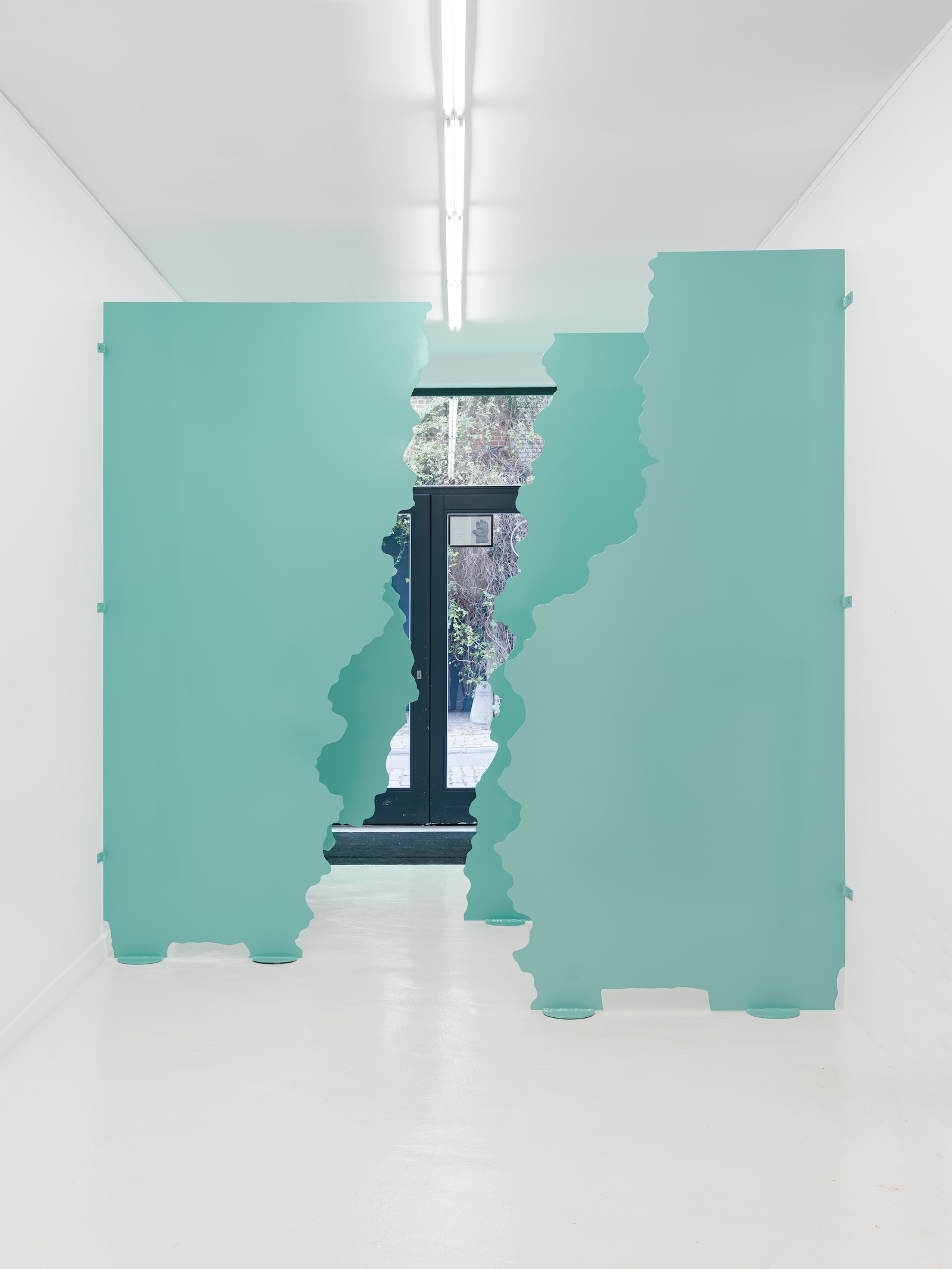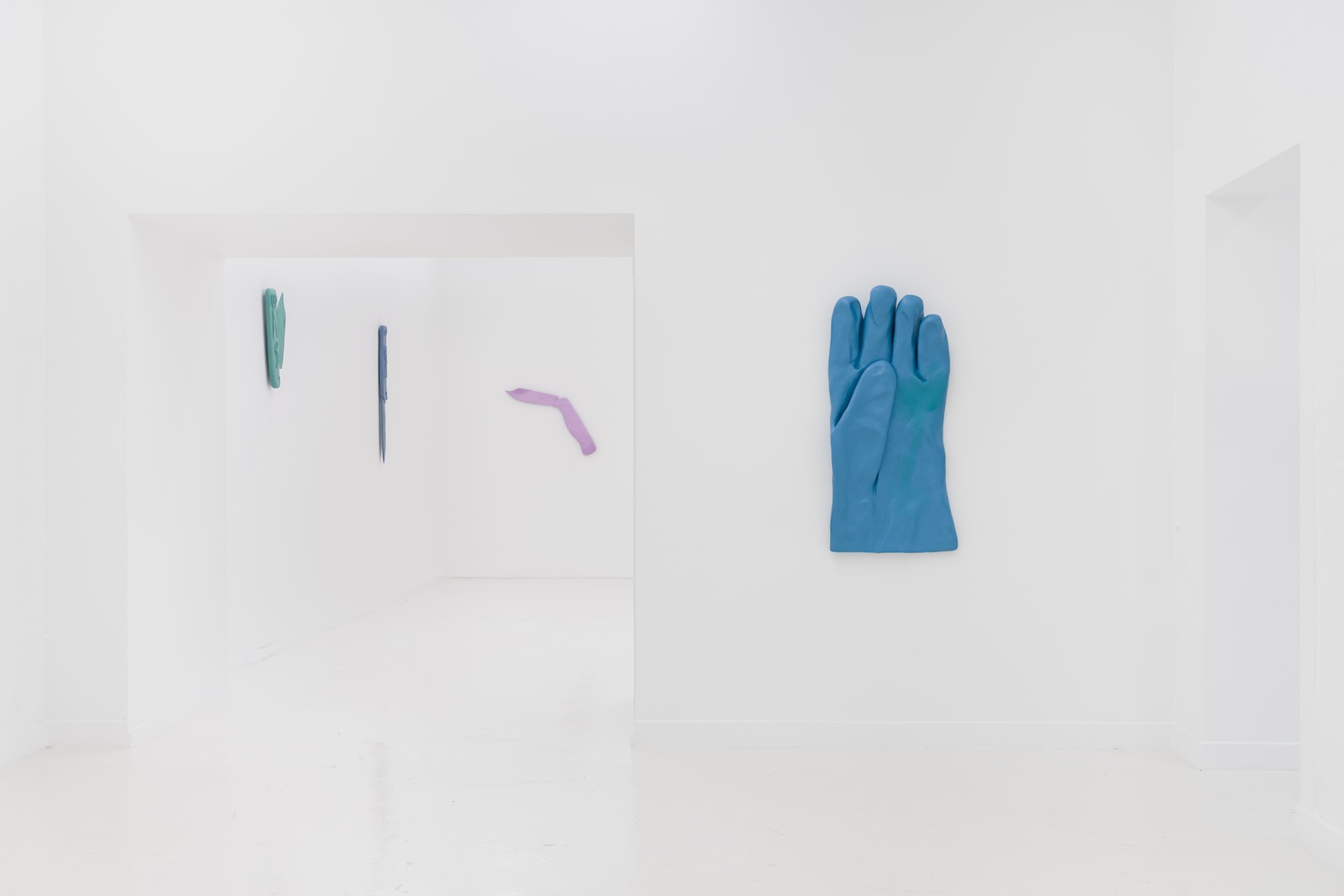13 october 2024, Wouter van den Eijkel
The studio of... Alice Vanderschoot
Alice Vanderschoot's first solo exhibition at BARBÉ is titled Le Palais Idéal, a reference to the life's work of 19th-century French postman Ferdinand Cheval, who, over the course of 33 years, built a palace based on images from postcards. "To me, the idea that someone could create an entire world from the pictures on postcards, and that migration of symbolism and forms, is a kind of internet avant la lettre."
The migration of symbolism and forms is the theme of the work in Le Palais Idéal. In addition to sculptures of enlarged gloves and overalls, there are six wall sculptures of Swiss army knives with numbers, arrows and symbols on them. They seem to be placed randomly, but when you look at the perfect finish of Vanderschoot's works, it's hard to believe.
They are not entirely random, the artist explains. "I grew up with comics and cartoons, the birth of the internet and social media. So, my work relates to art and other history and the visual language of that time on the one hand and my environment on the other." Vanderschoot's symbols tell us something about how forms of communication are constantly evolving and how we as humans deal with that.
Le Palais Idéal can be seen at BARBÉ in Ghent until 20 October.
You live and work in Bruges. In this video by BARBÉ, we see, among other things, a large chalkboard. Are you actually based in a former school building?
I moved to Bruges in 2015, where my parents and grandparents had already relocated. It took some time to find a workspace, so for the first few months, I commuted between my studio in Ghent and Bruges. If you really want something, you have to talk about it often to lots of people. Eventually, I ended up together with a small group of artists with an organisation that had been considering providing studios for artists for years, but didn't know if there was a demand for it.
After six years at the first location, with incredible views of the Burg and Markt, we moved last year into a building outside the city centre, a former school. My studio is located in the old home economics and chemistry classroom, although you can’t tell. But the large chalkboard remains, where I now write a plan for the coming weeks in chalk. When you work with the slow process of fittings, clay, and moulds, planning the different stages of a sculpture far enough in advance becomes a necessity. Otherwise, time catches up with you.
Time is also an important aspect of my work and very present in my current solo exhibition, which includes six Swiss army knives, which, by depicting them in different positions, function as clocks.
What does a typical day in your studio look like? Are you someone who starts early or not so much? Is it quiet while you work or do you listen to music? And do you welcome visitors?
I'm increasingly realising that I need structure and my studio functions better when my days are organised and the activities for the day are somewhat planned. But I still have a lot of freedom to do what I want. Whereas I used to regularly work into the wee hours, I now prefer an 8-to-8 day.
On days when I'm not teaching, my studio day starts around 8 a.m., but I rarely stay later than 8 p.m. The very first thing I do is put on work clothes. I then spend the next few hours in silence. Music and podcasts can sometimes be distracting, but are a good buffer when there's a lot of background noise. My work attire consists of overalls, which you can also see hanging in the studio in the trailer. These overalls without a figure have became a sculpture that is also on display in the exhibition.
I sometimes really enjoy visitors and like to have conversations with my gallerist Oliver, my partner and other artists, but I also deliberately schedule times with few or no visitors. Sometimes I leave the lights off, so it looks like no one is there.
Your exhibition is called Le Palais Idéal. What makes the perfect studio for you?
Like Ferdinand Cheval, I dream about the perfect workspace, preferably close to or at home and in a peaceful environment. It would consist of a work studio with lots of natural light, but also a 'clean' space where I can draw or make smaller work, and a dust-free place to store my books, ceramics like apothecary jars, ceramic dogs and now a collection of gloves. My partner enjoys cooking and we like to have friends and family over for dinner. So, the ideal studio would also have an outdoor area with a long table on sawhorses, where we can host people and everyone knows their way to the kitchen.
Congratulations on the show, by the way! The title refers to the life's work of 19th-century French postman Ferdinand Cheval. Not everyone is familiar with know, so how did you come across him? What attracted you to his work?
As a child, I visited the palace during a family holiday and last summer, went there again with my partner. The naive but apparently unclassifiable architectural style of the palace, built single-handedly, was designated a historic monument in 1969. To me, the idea that someone could create an entire world from pictures on postcards, and that migration of symbolism and forms, is a kind of internet avant la lettre. It says something about the human and artist's drive to leave something behind, the disappearance of meaning and the connection of cultures and different eras.
The show includes wall sculptures of enlarged gloves and Swiss army knives. They are meticulously recreated, including creases in the leather. Why do you draw our attention to such objects?My grandfather introduced me to the existence of ex-votos, small sculptures made of wax and silver, offered in thanks for healing or as a plea for healing to a saint. It's a ritual that exists in many cultures in different forms but has long disappeared from Western culture. The gloves and work tools like knives and hammers that I use daily in the studio became, in a way, my own metaphor and protection for various things as an artist. By enlarging everyday objects like gloves, a sense of alienation arises, which makes me reflect on the purpose of our existence.
The sculptures feature numbers, symbols and body parts—I saw an ear on a Swiss army knife. They seem to have been placed randomly on the work, but given the meticulous finish of your works, I find that hard to believe. How do you decide which symbol or emblem to use where? Is there logic behind it?
The symbols work both ways: they originate from educational prints like the legends on botanical drawings and are meant to make a work more readable, but also mislead the viewer. The old mansion where my studio is located has been a school since the 1950s, originally run by nuns, and there are still many remnants of that, including the presence of arrows. Initially, they directed students to different classrooms and the dining hall, but also served as fire escape routes, directional signs from the pandemic years and the most recent arrows for visitors to the open studio days. It made me notice arrows everywhere: in traffic, at the supermarket, as well as indicators in my sketchbook.
The text accompanying Le Palais Idéal mentions the contrast between contemporary pop culture and medieval motifs as a central theme in your work. Do you agree with that and if so, what question are you raising with it?
Throughout art history, artists have always taken a clear position in relation to their time. I grew up with comics and cartoons, the birth of the internet and social media. In this way, my work relates to art and other history and the visual language of that time on the one hand and my environment on the other. It says something about how forms of communication are constantly evolving and how we as humans deal with that.
Cheval worked on his dream palace for 33 years. I hope your next exhibition won't take that long! Are there projects you'd like to carry out but haven't gotten around to yet?
This might not be immediate, but I'm cautiously toying with the idea of executing a work in bronze, a material that is undeniably present in the tradition of sculpture but not easy to start with. There are a few ideas in my head for which the material would be perfect. If I had the chance to create a work that would remain in public space or a park for a long time, I would be very happy.
What are you working on right now?
At the moment, I’m working on the largest sculpture I've ever made in terms of scale. It’s part of a project in the city of Dendermonde, where five artists are creating works for public space in 2024 and 2025. On the outer wall of an old brewery, there will be a playing card with two Long John Brewery Gloves depicted in relief. The playing cards are part of a series I've been working on for the past few years, with each card assigned a new symbol that becomes part of a new hierarchy carried by the playing cards as we know them.
In early November, Life in the Margin will open in the Gevaertsdreef in Oudenaarde, a group exhibition for which the artist Ellen Pil and I are bringing together twelve artists. The exhibition runs parallel to the historical exhibition on the life of Margaretha of Parma at the MOU and will showcase the work of contemporary artists whose work takes a different approach to traditional thinking.
The exhibition Le Palais Idéal by Alice Vanderschoot will be on view at BARBÉ until 20 October 2024.



